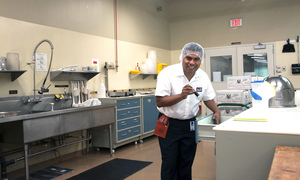Sanitary Design

As a food safety manager or team member, you have a responsibility to ensure a robust food safety plan is developed, implemented, and fully understood within your organization. You have probably spent countless hours reviewing elements of your food safety plan each time a failure, customer complaint, or audit/inspection finding occurs. You’ve adjusted your cleaning schedules and procedures, GMP policies, metal detection program, preventive maintenance work instructions, glass and brittle plastics log, etc. But, when was the last time you had a specific issue and reviewed your sanitary design standards to look for a root cause?
In order for food safety to evolve in your organization, sanitary design needs to be looked at as a fundamental prerequisite equal to all other prerequisite programs.
Sanitary design applies design techniques that allow timely and effective cleaning and inspection of equipment and facilities, and minimize the potential for contaminants to be introduced to food products. The ultimate goal is that the food produced is safe and suitable for human consumption.
Consumers expect and demand a safe food supply. To get there, microbiological, chemical, and physical contaminants that lead to food safety issues must be prevented. For sanitary design to address those issues, it must cover equipment, tools, buildings, and grounds.

Sanitary Design Regulations
Sanitary design is driven by many sources at this point. Design regulations can be found in the European Union, Codex, and FDA Good Manufacturing Practices, 21 CFR part 110. The GMPs have two sections that specify construction and design standards.
- Section 110.20. Buildings and structures are required to be suitable in size, construction, and design to facilitate maintenance and sanitary operations for food manufacturing purposes. The objective is to look at a facility as a whole and determine necessary design measures for the specific environment.
- Section 110.40. Equipment and utensils are required to be designed and constructed of materials that are easy to adequately clean and properly maintain. Equipment and utensils and their usage should prohibit the adulteration of food with lubricants, fuel, metal fragments, contaminated water, or any other contaminants. This section of the GMPs goes into more detail and should be fully reviewed to ensure the concepts and requirements are understood.
Sanitary design is being addressed in third-party audit standards and Global Food Safety Initiative (GFSI) audit schemes. Auditors are now looking for a written program and specific standards that address sanitary design. It is important for your food safety team to identify the types of products produced and determine the risks associated with those products. This will allow you to choose the proper standards and develop your own sanitary design guidelines. There are several standards to choose from, including:
- The GMA Equipment Design Checklist for Low Moisture Foods and the GMA Facility Design Checklist. These were developed to support and identify specific principles of sanitary design for food processing equipment and food processing establishments. These tools will help designers identify problem areas and potential design flaws that limit the effectiveness of cleaning and operational sanitation concerns.
- Hygienic Equipment Design Criteria. These were developed by the European Hygienic Engineering and Design Group (EHEDG) and detail the principle hygienic-design criteria to be met by equipment for food processing. They give guidelines on how to design, construct, and install equipment; they apply to durable equipment used for batch and continuous open- and closed manufacturing operations.
- ANSI Z50. The Z50 standard for bakery equipment was developed to help equipment manufacturers demonstrate that bakery equipment is designed to minimize the risk of product contamination and maximize cleanability and operational efficiency.
Other Standards

There are other standards for specific industry segments, including meat, dairy, and produce. It is important to determine which standards your company should use. Sanitary design should support the cleaning and maintenance of equipment and structures. Keep the following considerations in mind.
- Cleanability. Equipment must be accessible and able to maintain a standard level of cleanliness. Surfaces should be cleanable, and the equipment should be monitored prior to startup. Equipment selection should be validated to ensure it is appropriate for the product and operation. The method of cleaning should be incorporated into the design so that cleaning-time targets can be met, and the equipment should be free of apparent flaws that will make it uncleanable.
- Made of Compatible Materials. Construction materials must be completely compatible with the product, environment, chemicals used, and methods of cleaning and sanitation. Product-contact surfaces should be corrosion resistant, non-toxic, non-absorbent, durable, and approved by regulatory agencies. Parts should remain intact throughout cleaning and sanitation protocols and be easily removed and replaced as needed. Food-contact surfaces or process equipment surfaces above product zones should not have any plating, paint, or coatings.
- Distinct Hygienic Zones Established in the Facility. Manufacturing areas should be separated based on activities conducted within them to minimize cross-contamination from one area to another. This distinction could include:
- Wet and dry areas.
- Raw materials and finished product areas.
- Uncooked and cooked areas.
- Basic hygiene areas and high hygiene areas.
- Room Air Flow and Room Air Quality Controls. Suitable air pressure differentials should be maintained between adjacent areas/zones. Compressed air should be dry, oil-free, and filtered to remove foreign particles. Air quality considerations should factor in room temperature and measures to prevent condensation. The air should flow from clean to less clean areas or from non-allergen areas to areas that contain allergen products. Critical process air should be adequately filtered.
Your organization must establish sanitary design standards to minimize the risk of contamination from microbiological, chemical, and physical contaminants. development, implementation, and understanding of these standards will help you produce a safe food product.
When you design and install your bakery equipment in compliance with the ANSI Z50 Standards for Baking Equipment, your risk of product contamination lessens and your operational efficiency grows! Learn to apply Z50 standards to the design and installation of your products at our February seminar!
Pingback from mpofcinci.com
https://www.mpofcinci.com/blog/guide-to-sanitary-and-hygienic-design/
This is a great article and summary on the importance of Hygiene Standards and need for Sanitary Equipment in the food industry. Working for Deville Technologies has further reinforced the importance of Sanitary Food Cutting Solutions in the industry for me. We have seen from start-ups, to fortune 500 companies pay a heavy price for cutting corners with less costly, less sanitary equipment. Not only is the risk of contamination detrimental to a companies reputation and existence, but the costs of sanitation, labour and maintenance rises as well.
Christopher AltmannDeville Technologies - Market Manager Cheese


